finding the right social media influencers
Social media influencers can give your business a leap from zero to its apex because that’s what they do. Influencers have a deeper understanding of their audience and are more trusted by them. So whatever they introduce to them ultimately sells, but how well it sells and whether this can be quantified is often a struggle to discern. It can be difficult to put your brand in the hands of the right social media influencer, and you need to ensure they are looking after your best interests. This becomes even more critical as consumer behavior evolves.
With consumers increasingly craving genuine human connections amid the rise of AI-generated content, strategic influencer partnerships are more valuable than ever. Here’s a thorough approach to finding perfect influencer partners who can drive meaningful ROI for your brand.
Understand Your Target Audience First
Before diving into influencer search, establish a crystal-clear picture of your target audience:
- Which platforms do they actively engage with most frequently?
- What content formats captivate them and drive engagement?
- Which influencer personalities and content styles resonate with them?
Your audience’s preferences should guide your influencer selection. For example, if your customers primarily spend time on TikTok but you’re partnering with LinkedIn thought leaders, your campaign will likely miss the mark.
Define Clear Campaign Objectives
Different influencers excel at different objectives, so before starting your search, clarify whether you’re looking to:
- Increase brand awareness among new audiences
- Drive direct sales through affiliate links or promo codes
- Build credibility in a new market segment
- Generate buzz around a product launch
- Provide authentic product reviews that build trust
These goals will help you identify influencers whose strengths and content styles align with your specific marketing needs.

Know the Different Types of Influencers
Understanding the influencer landscape helps you target your search effectively. The industry generally recognizes four main categories:
- Mega-influencers (1M+ followers): Celebrities and major social media personalities who offer enormous reach but come with premium pricing
- Macro-influencers (100K-1M followers): Established content creators who are influential voices within specific niches
- Micro-influencers (10K-100K followers): Rising creators who often have higher engagement rates despite smaller audiences
- Nano-influencers (under 10K followers): Hyper-niche content creators with highly engaged, loyal communities
The right tier depends on your budget, goals, and target audience. While mega-influencers provide maximum exposure, micro and nano-influencers often deliver better engagement rates and more authentic connections with their audiences.

Look Beyond Follower Count
While reach matters, engagement is the true key to influence. A micro-influencer with 10,000 highly engaged followers often delivers better results than a celebrity with millions of passive followers. When evaluating potential partners, examine:
- Engagement rates (likes, comments, shares relative to follower count)
- Comment quality (meaningful conversations vs. emoji spam)
- Audience demographics (do they match your target customer?)
- Growth patterns (steady, organic growth vs. sudden spikes that might indicate purchased followers)
Assess Content Quality and Brand Alignment
Review potential influencers’ content thoroughly:
- Does their aesthetic and visual style complement your brand identity?
- Is their tone and messaging consistent with your brand voice?
- Do they create high-quality, thoughtful content that showcases products effectively?
- Do they already mention or use products similar to yours in an authentic way?
The best partnerships feel natural to followers because there’s authentic alignment between the influencer’s established content style and your brand. For example, a sustainability-focused skincare brand would benefit more from partnering with creators who already share content about ethical consumption rather than generic beauty influencers.
How to Find Relevant Influencers
Several approaches can streamline your search:- Use specialized platforms: We’ve seen tools like Sprout Social Influencer Marketing offer powerful search filters and data analytics to find ideal matches based on audience demographics and engagement metrics.
- Leverage hashtag searches: Search industry-specific hashtags on platforms where you want to run campaigns. For example, sustainable fashion brands might explore #sustainablefashion on TikTok or Instagram.
- Analyze competitor partnerships: Study which influencers your competitors work with, then examine who those influencers follow or engage with to discover similar talent.
- Implement social listening: Track mentions of your brand to identify creators who already use or discuss your products organically.
- Attend industry events: Connect with potential influencer partners at creator conferences.
- Network referrals: Ask your professional network for recommendations of influencers who might align with your brand values.
Measure and Refine Your Strategy
The most successful brands treat influencer marketing as an evolving strategy:
- Set clear KPIs for each campaign
- Use unique tracking links, custom URLs, or promo codes
- Gather qualitative feedback from customers about influencer content
- Build long-term relationships with top performers rather than one-off collaborations
- Compare performance across different influencer types and platforms
By continuously measuring results and refining your approach, you’ll develop a network of authentic influencer partners who genuinely enhance your brand presence and drive measurable business outcomes.


